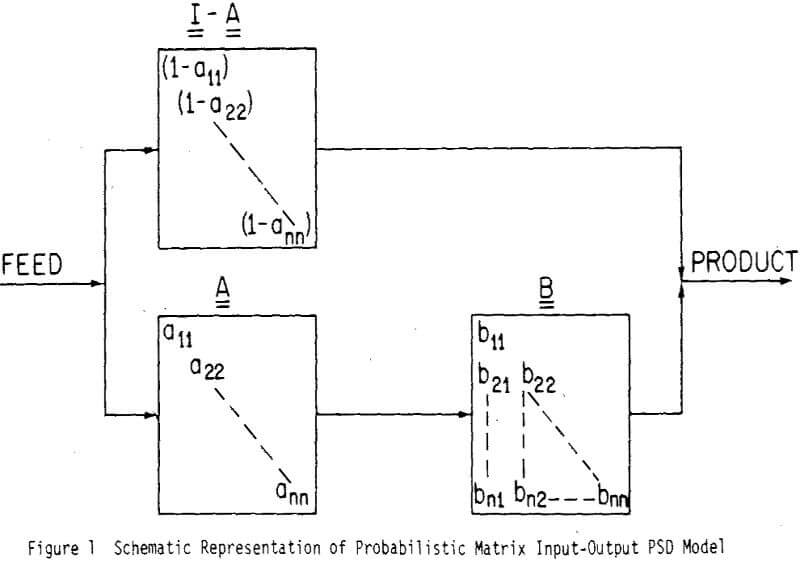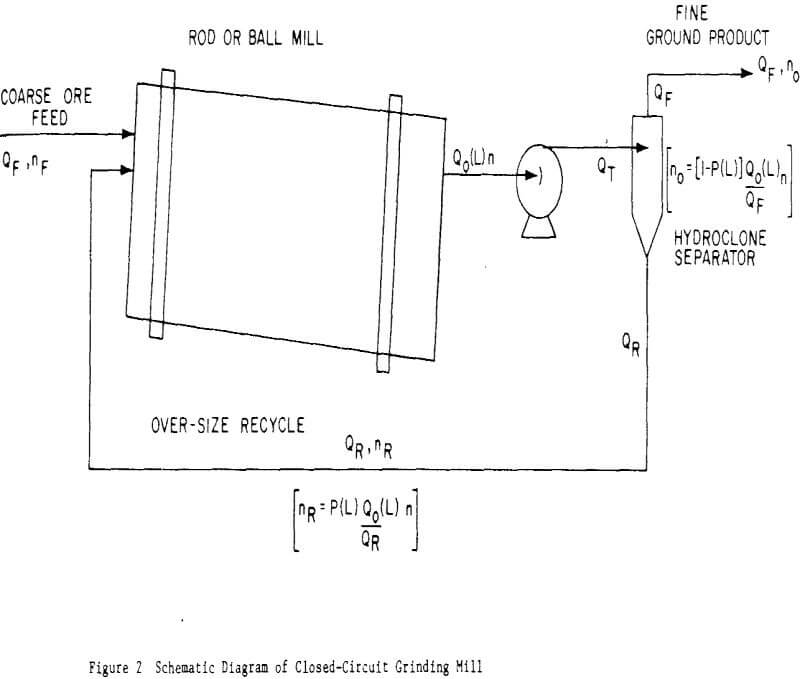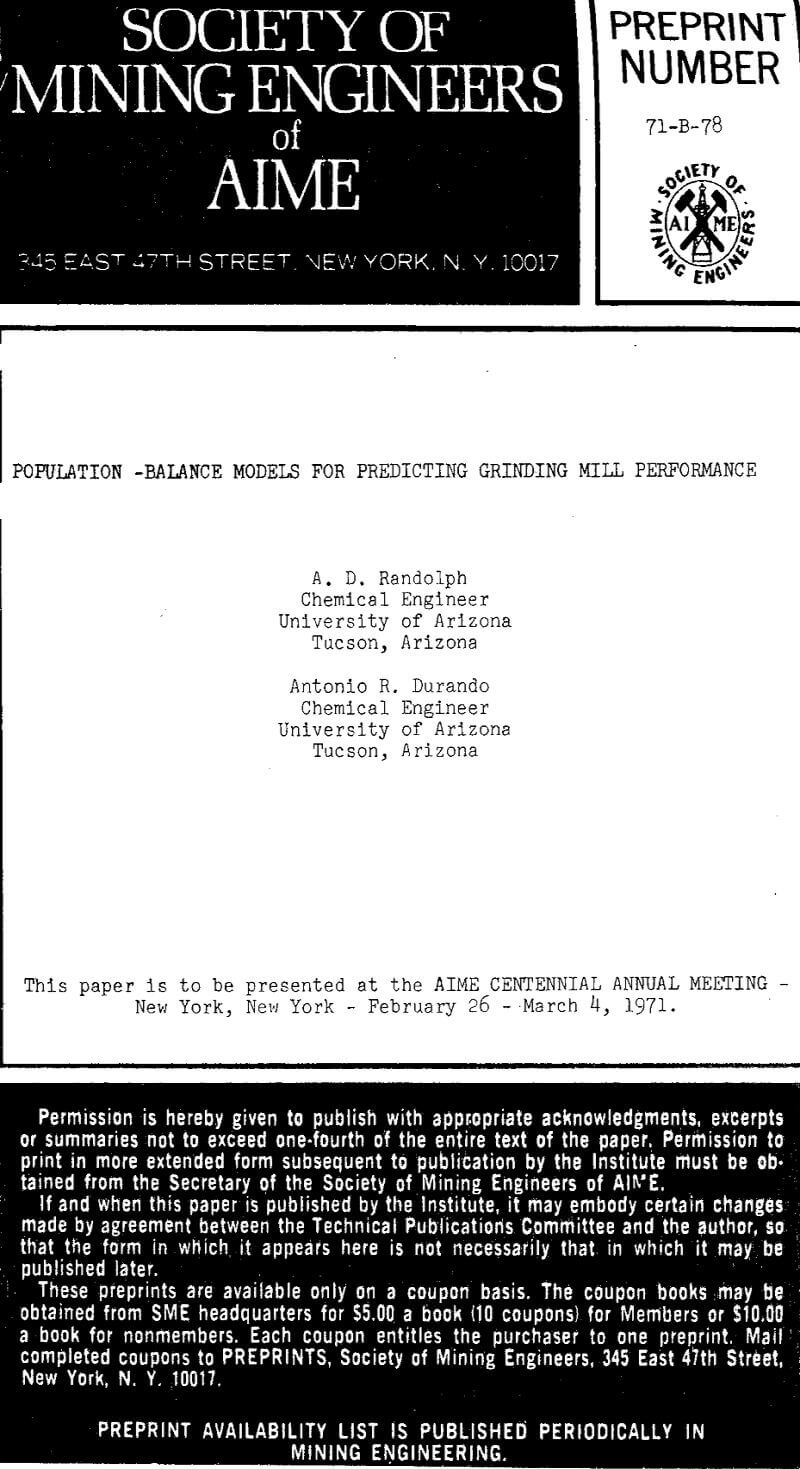Comminution represents one of the major costs.of mineral recovery from low- grade ores. Efficient mineral recovery in a typical low-grade ore grinding-flotation process depends on grinding the ore small enough to liberate mineralization without producing excessive slimes, which would result in higher power and flotation reagent costs. Size criteria for efficient grinding should be stated in terms of the distribution of mineralization sizes, but as the mineralization-size distribution is difficult to determine, less desirable criteria of absolute particle-size distribution (PSD) are used in practice.
More recent PSD models for grinding mills have combined discrete kinetic breakage models, stated probabilistically and similar to those in the matrix approach, with mass balances over specific process configurations to predict the resultant PSD in that configuration.
The breakage kinetic rate constant can be measured directly from batch grinding data. Such studies usually indicate that breakage can be represented by simple first order kinetics. Thus
dmi/dt = Kimi….. 1
where mi is the mass in the i’th discrete size range and Ki is an over-all breakage constant depending on mill design, ore hardness, and operating conditions.
Development of Population Balance PSD Model
The central equation of this particulate theory is the population balance taken over particle phase space; a particle continuity equation similar in form to the Liouville equation of statistical mechanics. In its most general form this balance can be stated as
![]()
where n is the population density, no./gal-µ, v is the convective velocity along some suitably defined internal particle phase space, µ/min, V is some process, volume of interest, gal, Qj is the j’th slurry stream entering or leaving volume V, gpm, and B and D are the population birth and death terms, no (gal-µ-min) representing particle breakage in the case of comminution processes.
![]()
where Ve is the average spatial particle velocity. These two forms of the population balance, the macro-distributed and the micro-distributed forms, describe particle-size distributions in backmixed and spatially distributed systems, respectively.
The classifier size-separation factor, P(L) , can be determined independently by measuring particle concentrations as a function of size in hydroclone feed, overflow, and underflow. Hydroclones operate by excluding over-size from the overflow rather than concentrating the undersize. Thus, if the fraction of feed material at a given size reporting to the underflow is plotted versus size the separation curve asympototes for zero size at the underflow to feed ratio, QR/QT and asymptotes at unity as size increases. The size at which 50% of the particles are removed from the overflow is termed the size-separation or “cut-point” of the classifier under those conditions of operation.
Experimental
The above-described population balance model of a grinding mill was used to fit PSD from three different mills of different size and design operating on three different ores. Size-independent residence time in the mill was assumed. A simple specific form of the breakage functions was assumed and two adjustable parameters in the breakage model were varied in an attempt to fit input-output steady state PSD over a range of throughputs and feed distributions.
nF – n/T + B – D = 0
where T = V/Q, the mean particle retention time in the mill. A simple first order power-law form was assumed for the death term. Thus
D(L) = knLβ
where k and β are adjustable parameters representing breakage rate and size-selectivity, respectively.
Five sets of grinding data from a commercial ball mill operating with slurry residence times of 2.8 to 4.0 minutes were analyzed. These residence times correspond to throughputs ranging from 112 to 80 T/hr of ore. The run at 80 T/hr, corresponding to T = 4.0 minutes, was simulated with the model to fit the output PSD. The optimum choice of parameters based on this four minute retention run was found to be k = 800 and β = 3. The predictive value of the model was tested by simulating PSD with different feed rates and feed distributions using these same values of k and β. Prediction of PSD for different operating conditions was excellent. Figure 4 shows the excellent agreement between experimental and predicted PSD for the maximum throughput case (P = 112T/hr, T = 2.8 minutes) predicted from parameters obtained by analyzing data at the lower throughput.
Finally, the model was tested with a third set of data on an ore of a different nature, limestone, to demonstrate model sensitivity to the physical characteristics of the feed. It was found that a single output distribution could still be fitted with good accuracy, but predicted PSD’s as a function of residence time did not closely match the experimental data.
In the preceding three examples, the population balance in particle phase space has been used as a format for insertion of simple two-body, two-parameter, continuous breakage empiricisms to simulate PSD in three grinding mills of widely different design, size, and ore type. Prediction of PSD in the face of throughput changes was excellent, good and poor in these three cases. It should be recognized that the population balance theory represents a completely general format within which all levels of assumptions can be made with no inconsistencies.
If a predictive model capability cannot be achieved over the range of chosen parameters, then the form of model is inadequate and must be changed. The form of assumed breakage mechanisms represents the next level of empiricism and is the first model structure that should be changed. Although the birth and death functions are empirical, and thus arbitrary, some generalization can be made and certain internal consistencies must be observed.
A PSD model of a grinding circuit has been presented based on insertion of size-continuous breakage impiricisms in the format provided by a population balance in particle phase space. Such models link PSD and throughput factors and should be useful in understanding and improving mill performance as well as in the quantitative evaluation of novel mill control schemes, e.g. control with the aid of on-line particle-size sensors.



